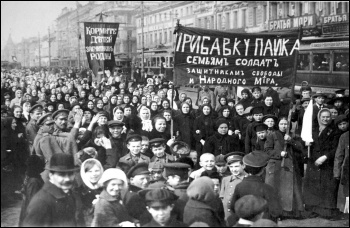Iain Dalton, Leeds Socialist Party
When people think of the year 1917 and the ‘soviets’ – democratic councils of workers and soldiers – they are inevitably drawn towards the magnificent events of the Russian revolution.
Less known is that the labour movement in Britain also gathered that year attempting to establish its own ‘councils of workers’ and soldiers’ deputies’.
On 3 June 1917, 1,150 delegates gathered in Leeds to discuss the lessons of the February revolution which overthrew the tsar in Russia.
Included on the convention platform was future Labour prime minister Ramsay MacDonald on the one hand, and on the other radicals who would play important roles in the as yet unfounded Communist Party such as Tom Mann and Willie Gallacher.
It was far from the first labour movement event in Britain to hail the revolution. Workers welcomed the fall of the tsar, the despotic ruler of Russia, and sought to press their own demands for democracy and civil liberties across Europe.
Similarly welcomed was the declaration of the new soviet government after the second revolution in October for a “peace without annexations or indemnities, on the basis of the self-determination of peoples,” bringing an end to the First World War.
The revolution was the theme of many of the traditional May Day demonstrations. 70,000 marched in Glasgow and 50,000 in London on such themes.
Leeds itself had its own May Day demonstration on these lines, and also hosted the conference of the Independent Labour Party, whose discussions had centred on this event.
That the gathering was taking place at all terrified the authorities. They sought to cancel the hotel bookings of the delegates, and forced them to move from their original venue in the town to the Coliseum (now the O2 Academy).
The centrepiece demand – for the formation of workers’ councils – was the most controversial, and in all likelihood the one that the authorities feared the most. Yet this did not come to fruition.
District conferences, which the convention had called for, found venues cancelled, meetings banned and other obstacles. The provisional committee elected by the convention was not up to the task set for it of building this movement.
As Bertrand Russell commented, it “was a wonderful occasion, but a little disappointing from the point of view of practical outcomes. Snowden and MacDonald and Anderson are not the right men – they have not the sense for swift dramatic action.”
Yet this was not the end of the story. ‘Councils of action’ were later formed against British support for the reactionary ‘Whites’ attacking the Russian revolution.
This included the famed ‘blacking’ of the SS Jolly George – dockers refusing to load it – because it was taking weapons to Poland to arm the Whites.
Such organisations rose again in Britain’s 1926 general strike. In parts of the country, they began to form a rival government to the Tories. Disgracefully, the leaders of the Trade Union Congress scuppered that movement.
But ‘soviets’ or ‘councils of action’ remain a key weapon of the workers’ movement when it enters into the struggle for power with the capitalists.
- ‘Russian Revolution: 100 Years Since the 1917 Leeds Convention’ event hosted by Leeds TUC, Saturday 3 June 10am-4pm at Swarthmore Education Centre, 2-7 Woodhouse Square, Leeds, LS3 1AD








